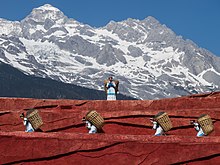Jade Dragon Snow Mountain
| Jade Dragon Snow Mountain | |
|---|---|
Ultra | |
| Coordinates | 27°05′54″N 100°10′30″E / 27.09833°N 100.17500°E[1] |
| Geography | |
, Yunnan | |
| Parent range | Yulong Mountains |
| Climbing | |
| First ascent | 1987 by Phil Peralta-Ramos and Eric Perlman[2] |
| Easiest route | East side: snow/rock climb[2] |
Jade Dragon Snow Mountain (
Etymology
The Chinese name, Yùlóng Xuěshān, translates directly as Jade Dragon Snow Mountain; it is sometimes translated as Mount Yulong or Yulong Snow Mountain.[6] The mountain's Naxi name is Mount Satseto.[7]
Geography
The Jade Dragon Snow Mountain massif forms the bulk of the larger
Settlements surrounding Jade Dragon Snow Mountain include
Exploration history
In 1938, an expedition led by the Australian lawyer, feminist, conservationist, and mountaineer, Marie Byles, failed to reach the summit due to bad weather.[9] Bitterly disappointed by this failure, she became a follower of Buddhist thought as a consequence.[10][11]
Shanzidou has been climbed only once,
The Austro-American botanist and explorer
Tourism

The view of the massif from the gardens at the
The mountain was featured on Episode 4 of The Amazing Race 18.[17]
-
Yak and cascading pools with the mountain in the background
-
View of Jade Dragon Mountain
-
Yulong Snow Mountain Waterfall
-
Glacier on top of the mountain
-
Yunnan Black-Dragon-Pool
-
A view approximately 900m below the summit
-
The characteristic of the Blue Moon Valley of Yulong Snow Mountain: water renowned for its "milk" color and its "pure" quality becomes blue when the weather is nice.
References
- ^ a b "China III - Sichuan and Yunnan Provinces". Peaklist.org. Retrieved 2014-08-25.
- ^ a b c Eric S. Perlman, "Yulong Shan", American Alpine Journal, 1988, p. 265.
- ^ a b Tianxin, Zhang; Takayoshi, Yamamura; Funilki, Yosuke (2005). "Conserving the comprehensive image of natural settings for World Heritage Sites: A case of the Yu-Long-Xue-Shan Snow Mountain as the landmark for the Old Town of Lijiang" (PDF). Xi'an, China: 1–7.
{{cite journal}}: Cite journal requires|journal=(help) - ^ JSTOR 3673299.
- ^ "玉龙纳西族自治县概况 - 玉龙县 - 丽江市人民政府". www.lijiang.gov.cn. 2021-10-25. Archived from the original on 25 October 2021. Retrieved 2022-01-17.
- LCCN 2014951737.
- Exotissimo. Archived from the originalon January 24, 2013. Retrieved December 13, 2012.
[Jade Dragon] mountain, also called Satseto in the Naxi language, takes its name from the God of War in the Dongba religion.
- ISBN 9787503141782.
- ^ Byles, Marie B. (June 1939). The Sansato Massif. Dunedin, New Zealand: New Zealand Alpine Club. pp. 18–24.
- ^ Julie Petersen. "Marie Byles: A Spirited Life". Reflections: The National Trust Quarterly (Feb–Apr 2005). The National Trust of Australia (NSW): 17–20.
- ^ Melbourne, The University of. "Byles, Marie Beuzeville - Biographical entry - Australian Women Lawyers as Active Citizens". www.womenaustralia.info. Retrieved 2020-01-19.
- ^ Tamotsu Nakamura, "East of the Himalaya", American Alpine Journal, 2003, p. 146.
- ^ Chatwin, Bruce. "In China, Rock's Kingdom", The New York Times, March 16, 1986
- ^ Chatwin, Bruce (1989) "Rock's World", in What Am I Doing Here?, Vintage, p.206
- ^ Palin, Michael (2005) "Himalaya - Day 82: Lugu Lake to Lijiang", Retrieved 2011-01-13
- ^ "AAAAA Scenic Areas". China National Tourism Administration. 16 November 2008. Archived from the original on 4 April 2014. Retrieved 9 April 2011.
- ^ Franich, Darren (14 March 2011). "The Amazing Race recap: Zodiac Yak Attack". Entertainment Weekly. Retrieved 21 July 2020.








